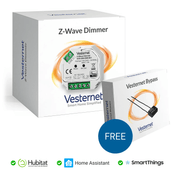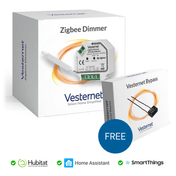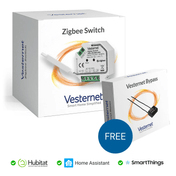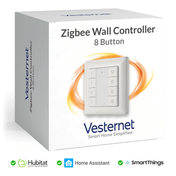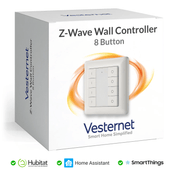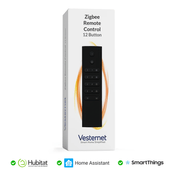Smart plugs have become essential for modern home automation, but choosing between premium features and practical simplicity can be challenging as the market offers increasingly sophisticated options. With smart plug energy consumption becoming a priority for homeowners seeking to reduce electricity costs, selecting the right device requires careful consideration of features, protocols, and compatibility.
This comparison will help you decide between Fibaro's feature-rich Z-Wave solution and Frient's streamlined Zigbee approach, showing which delivers better value for your specific automation needs. As UK smart home specialists, Vesternet has extensive experience with both Z-Wave and Zigbee ecosystems, providing unbiased insights from real customer feedback and technical testing.

The Fibaro Advantage: Premium Z-Wave Control with Visual Feedback
The Z-Wave Fibaro Wall Plug distinguishes itself through sophisticated engineering and comprehensive monitoring capabilities. Its standout feature is the crystal RGB LED ring that provides instant visual feedback about connected appliance loads, changing colour to indicate current power consumption levels.
Premium Features That Set Fibaro Apart
- Built-in temperature sensor with automatic safety alerts at 55°C
- Visual load monitoring through colour-changing LED ring
- Child safety mechanism with integrated plug cover
- Precise energy tracking down to individual device consumption
- Maximum load capacity of 2.5kW for high-power appliances
The Z-Wave protocol ensures robust mesh networking, creating a self-healing network that strengthens as you add more devices. This makes the Fibaro Wall Plug particularly valuable for comprehensive home automation systems where reliability and advanced power monitoring are paramount.

Frient's Simplicity: Straightforward Zigbee Automation
The Zigbee Frient Smart Plug Mini takes a refreshingly straightforward approach to smart home control. Designed for users who want reliable automation without complexity, it focuses on essential functions while maintaining broad compatibility with popular smart home platforms.
Core Functionality for Practical Automation
- Simple on/off control with scheduling capabilities
- Basic energy tracking for electricity usage awareness
- Compatibility with Homey and SmartThings hubs
- Compact design that doesn't obstruct adjacent sockets
The Frient's Zigbee connectivity offers excellent versatility, working with numerous hub manufacturers and providing reliable mesh networking. Its streamlined interface makes it ideal for beginners or users who prefer straightforward smart plug energy consumption monitoring without advanced features or visual indicators.
Protocol Wars: Z-Wave Precision vs Zigbee Versatility
Understanding the fundamental differences between Z-Wave and Zigbee protocols is crucial for making an informed decision. Z-Wave operates on dedicated frequencies (868.4MHz in Europe), creating less congested networks with superior range and reliability. Each Z-Wave network supports up to 232 devices with precise mesh routing capabilities.

Z-Wave Network Characteristics
- Dedicated frequency band reduces interference
- Longer range with stronger signal penetration
- Self-healing mesh network with automatic route optimisation
- Standardised interoperability between manufacturers
Zigbee operates on the 2.4GHz band, sharing spectrum with WiFi and other devices. While this can create interference challenges, Zigbee's adaptive frequency hopping and lower power consumption make it excellent for battery-powered devices and large sensor networks.
Zigbee Protocol Benefits
- Broader manufacturer support and device variety
- Lower power consumption ideal for sensors
- Faster data transmission for simple commands
- More affordable hub options available
Hub requirements differ significantly between protocols. Z-Wave devices need dedicated Z-Wave controllers, whilst Zigbee devices work with various platforms including SmartThings, Homey, and many others. This flexibility makes Zigbee more accessible for users with existing smart home setups, though Z-Wave's standardisation ensures consistent performance across different controller brands.
Real-World Performance: Load Monitoring and Network Reliability
When examining energy tracking capabilities, the Fibaro Wall Plug provides comprehensive power monitoring with precise measurements and historical data analysis. Its advanced sensors capture detailed electricity usage patterns, enabling users to identify vampire power devices and optimise consumption patterns effectively.
Fibaro Performance Metrics
- Accurate power consumption readings with historical tracking
- Real-time load visualization through LED colour changes
- Temperature monitoring prevents overheating scenarios
- Z-Wave mesh strengthens network reliability over time
The Frient Smart Plug Mini delivers reliable basic energy tracking suitable for general consumption awareness. While lacking the visual feedback of premium alternatives, it provides consistent performance for essential automation tasks and scheduling functions.

Network Reliability Comparison
- Z-Wave networks demonstrate superior range and penetration
- Zigbee networks offer faster response times for simple commands
- Both protocols create self-healing mesh networks
- Z-Wave shows better performance in challenging RF environments
Response times vary between protocols, with Zigbee typically offering faster command execution for basic on/off functions, whilst Z-Wave excels in complex automation scenarios requiring precise coordination between multiple devices.
Fibaro's Strengths and Limitations: When Premium Features Matter
The Fibaro Wall Plug's visual load indicators represent a significant advantage for users who want immediate feedback about connected appliance performance. The colour-changing LED ring transforms abstract energy data into intuitive visual cues, making power monitoring accessible without checking smartphone apps.
Premium Feature Benefits
- Temperature safety alerts prevent potential hazards
- Child safety mechanisms protect curious youngsters
- Precise load monitoring down to individual watts
- Superior build quality with nanometer-precision finishing
However, these advanced features come with increased complexity and Z-Wave ecosystem requirements. Users need compatible Z-Wave controllers, and the device's sophisticated features may overwhelm beginners seeking simple automation solutions. The premium engineering also reflects in higher costs compared to basic alternatives.
Frient's Trade-offs: Balancing Simplicity with Functionality
The Frient Smart Plug Mini's greatest strength lies in its user-friendly approach and broad hub compatibility. Its straightforward setup process and essential energy tracking features make it accessible to smart home beginners without sacrificing reliability or core functionality.
Simplicity Advantages
- Intuitive setup process requires minimal technical knowledge
- Compatible with multiple popular smart home platforms
- Essential energy tracking without overwhelming complexity
- Compact design doesn't block adjacent power outlets
The trade-off involves limited customisation options and fewer advanced features compared to premium alternatives. Users won't find visual load indicators, temperature monitoring, or detailed historical energy analysis. This streamlined approach suits practical automators but may disappoint tech enthusiasts seeking comprehensive control and monitoring capabilities.
Choosing Your Champion: Tech Enthusiasts vs Practical Automators
For smart home beginners and practical automators, the Frient Smart Plug Mini offers an ideal entry point into automated electricity usage management. Its straightforward functionality, broad compatibility, and essential energy tracking features provide excellent value without overwhelming complexity or steep learning curves.
Ideal Users for Frient Smart Plug Mini
- First-time smart home users seeking simplicity
- Renters needing portable, non-permanent solutions
- Budget-conscious users wanting essential automation
- Existing Zigbee ecosystem owners
Tech enthusiasts and advanced users will appreciate the Fibaro Wall Plug's comprehensive monitoring capabilities and premium engineering. The visual load feedback, temperature safety features, and precise energy tracking justify the premium positioning for users who value detailed control and monitoring.
Perfect Candidates for Fibaro Wall Plug
- Home automation enthusiasts wanting advanced features
- Safety-conscious families with young children
- Users seeking detailed energy consumption analysis
- Existing Z-Wave network owners
Professional installers and landlords might prefer the Fibaro's robust build quality and comprehensive safety features for rental properties, whilst DIY enthusiasts often gravitate towards Frient's accessibility and versatility. Consider your existing smart home infrastructure, technical comfort level, and specific monitoring requirements when making your selection.
Both devices excel in their respective market segments, with success depending on matching features to individual needs rather than choosing based solely on specification comparisons or initial costs.
Making the Smart Choice: Which Plug Fits Your Home?
Both the Fibaro Wall Plug and Frient Smart Plug Mini excel in their respective approaches to home automation. The Fibaro delivers premium features with its visual load monitoring, temperature sensing, and robust Z-Wave networking, making it ideal for users who value comprehensive control and safety features.
The Frient Smart Plug Mini offers practical automation with straightforward energy monitoring and broad hub compatibility, perfect for those seeking reliable functionality without complexity. Your choice ultimately depends on whether you prioritise advanced features and visual feedback or prefer simple, effective automation.
Key Decision Factors
- Existing smart home ecosystem compatibility
- Required level of energy tracking detail
- Safety feature importance for household needs
- Technical comfort level with complex features
Consider your existing smart home ecosystem, technical comfort level, and specific monitoring needs when making your decision. Browse both Fibaro and Frient products to discover which aligns better with your home automation goals.










